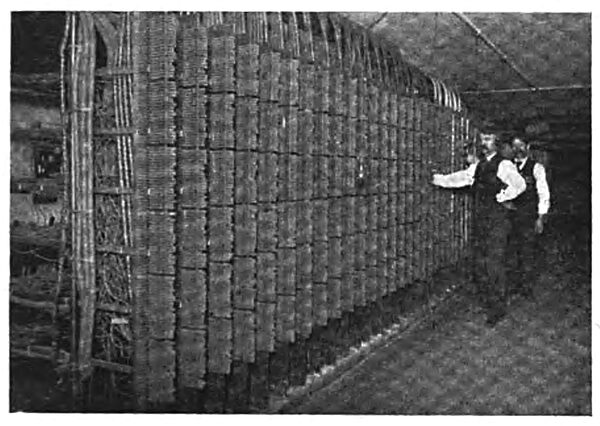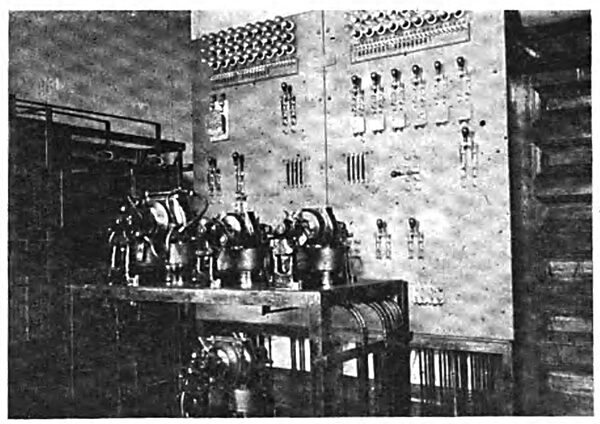[Trade Journal]
Publication: The Electrical Engineer
New York, NY, United States
vol. 26, no. 537, p. 145-146, col. 1-2,1
TELEPHONY
AND
TELEGRAPHY
The Central District and Printing Telegraph Co. —
Bell Telephone Interests in Pittsburg.
BY C. B. FAIRCHILD.
THIS is an odd name for a telephone company, but it is explained by the fact that when originally incorporated, it was designed to operate the Gray automatic printing telegraph instrument, as a branch of the Western Union business. It is now a telephone company, but supplies current for operating messenger call boxes for the Western Union Telegraph Co. of this city. The territory covered by the company’s franchise includes Western Pennsylvania, Eastern Ohio and West Virginia. The number of subscribers in May of this year, in the whole territory, was 19,397, of whom 7,095 are in the Pittsburg district, there being 2,923 in the Pittsburg main exchange, from which they operate 159 branches and over 700 public pay stations. Some idea of the magnitude of the business may be had from the statement that on May 10, the number of calls in the Pittsburg district was 97,042. The company occupies its own seven-story building on Seventh avenue, which was specially designed for the telephone business. The terminal room is located in the basement, illustrated in Fig. 1, and here the wires for the 4,200 lines are brought out from the cables in pairs of twenty. About 68 per cent, of the lines are metallic circuit. The main power station of the building is also located in the basement, and the equipment consists of two 50 h. p. Ball engines and two 400- lamp generators. Adjoining the engine room are a motor and seven small generators for supplying current to operate the messenger boxes, private telegraph lines and subscribers' desk telephones. A portion of the first floor and an adjoining building are used for the storage of material and for the setting up of telephones. The trouble department also occupies a room on this floor. In connection with the testing apparatus, is a small motor which supplies the current for operating the testing instruments. A fireproof cable tower extends from the basement to the top floor. This is said to be one of the best designed and most convenient cable towers to be found in any city. In this is placed a series of iron ladders, for convenience of placing the cables, and which can be used as a fire escape, should it become necessary. The telephone power room proper, illustrated in Fig. 2, is located on the top floor, and has an auxiliary storage battery equipment of six cells. There is a small generator with which the batteries are charged at night. These supply the current for the transmitters. Two other generators supply the current for the first class exchanges and other purposes.
| |||
| Fig. 1 — Terminal Room of Pittsburg Telephone Exchange. |
The operating department occupies the seventh floor, which is a large, airy room, and the main switchboard extends along two sides, with an auxiliary board on the opposite side, and the manager’s desk is near the middle of the room. The board accommodates sixty-two operators, and it is divided according to the requirements of the service for regular subscribers, trunk lines, pay stations, automatic local tolls and the long distance trunk lines. Some of the special features of the board include two miniature pilot lights on each panel, one white, the other red, to indicate the call, and when rung off. Some of the shutters are marked and striped in various colors, to indicate the character of the service being rendered the subscriber connected. The outgoing call panels of the toll board are provided with calculagraphs, which are placed flush with the counter, exposing the face of the clock. The record cards are inserted in a slot under the face when a call is made. The operator pulls a lever on the right and the time connection is made as indicated on a card by a printed dial. When the number is rung off, the operator pushes a lever at the left, and another dial is printed, indicating the time the communication ends. These cards also contain the number of the telephone calling and the operator’s number. The average number of calls answered per hour per operator is usually about one hundred and forty, the maximum, two hundred, but when the latter number is reached the lines are re-distributed on the board. Ten trunk lines connect with the office of the long distance system on the outskirts of the city, seven miles from the central exchange. The charge for unlimited service per year is [dollar:$125]. A measured service is also provided, as per the subjoined schedule: Long distance residence telephones, 400 "out" calls per annum. No limit to "in" calls. Four party lines, [dollar:$30], additional calls [dollar:5 cents each, or [dollar:$4] per annum. Schedule of special and party lines measured service for business and residence use:
|
In breaking in new operators, they spend two or three days watching one of the regular operators, and listening to the calls in answer, and when accepted, they are put on the half-day work, which begins at five and ends at ten o’clock p. m., for which they receive [dollar:$15] per month. The next shift from ten to seven o’clock a. m. receive [dollar:$25] per month. The regular day operators work ten hours, with forty-five minutes for lunch, and receive from [dollar:$25] to [dollar:$35] per month, depending upon the length of service, the maximum being reached after four years in the company’s employ. The monitors and assistant chief operators receive [dollar:$50] per month. The manager, Mr. S. M. Morrell, does not regard the work as being especially hard on the operators, some of whom have been at the business for fifteen years in this exchange. The list of applicants is usually 150 ahead.
| |||
| Fig. 2 — Power Room of Pittsburg Telephone Exchange. |
The company operate about 300 sub toll stations in connection with the Pittsburg Exchange system. These stations are located at convenient points throughout the district and are extensively used by parties whose business or social requirements do not justify subscription for regular exchange service.
The toll slot machines of the Gray telephone pay station type are used for many of these stations, and the service rendered is generally very satisfactory.
The business offices of the company are conveniently located on the different floors of the building, and the number of employes and canvassers is about 275. Mr. D. Leet Wilson, president Fort Pitt National Bank, is president; Mr. D. F. Henry, formerly well known in the street railway field, is vice-president; Mr. D. Paynter is superintendent; Mr. J. G. Stoakes, secretary and auditor, and J. M. Stephenson, treasurer.



